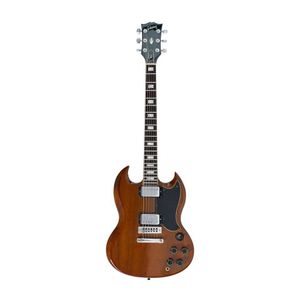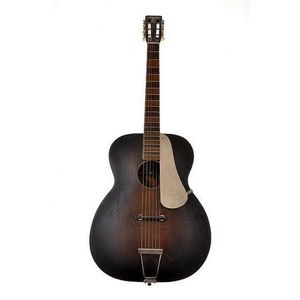1975 Gretsch Chet Atkins Super Chet Electric Guitar
You must be a subscriber, and be logged in to view price and dealer details.
Subscribe Now to view actual auction price for this item
When you subscribe, you have the option of setting the currency in which to display prices to $Au, $US, $NZ or Stg.
- Ebony - Ebony is a close grained timber, black in colour. It has a fine texture which can be polished to a high gloss, making it suitable for venereering, inlay and stringing and its use as solid timber is resticted to small decorative items and ornamental decoration, such as chess pieces and musical instrument parts. The term "ebonised" means "faux ebony", timber that has been darkened during the polishing process to resemble ebony.
- Maple - Maple, native to North America, is a dense heavy timber from light to yellow-brown in colour. It has very little distincive graining unless it is one of the variants such as birds-eye maple or burr maple, so was not used extensively for furniture in 18th and 19th century, where cabinetmakers and designers preferred timbers with more distinctive features such as mahogany, walnut, rosewood and oak.
Birds-eye maple has a seres of small spots linked by undulating lines in the grain, is highly sough and is used as a decorative veneer. Burr maple has larger and irregular grain swirls than birds-eye maple. - Mother-Of-Pearl - Mother-of-pearl, technical name "nacre", is the inner layer of a sea shell. The iridescent colours and strength of this material were widely used in the nineteenth century as an inlay in jewellery, furniture, (especially papier mache furniture) and musical instruments.
In the early 1900s it was used to make pearl buttons. Mother-of-pearl is a soft material that is easily cut or engraved.
Nowadays it is a by-product of the oyster, freshwater pearl mussel and abalone industries.
This item has been included into following indexes:
Visually similar items

A Gibson SG electric guitar, 1972, American made, serial number 700432 stamped to rear of headstock, six chrome plated machine heads, mahogany body and neck with walnut lacquer finish, East Indian rosewood fretboard with mother-of-pearl block inlays, mothe

A Gretsch 6192 'Sunburst' guitar, 1965, American made, serial number 65034, maple hollowbody construction, nitrocellulose 'Tobacco Sunburst' finish, bound 'F' holes, six gold plated Grover machine heads, bound maple body and neck, ebony fingerboard with 'T

Guitar, 1930's acoustic guitar by Regal 'Le Domino Big Boy' (faults)

A scarce 1979 Yamaha SG800 electric guitar, with red maple body, rosewood finger board, cream pick-guard, pick-up frames and matching detail to the body edge.
